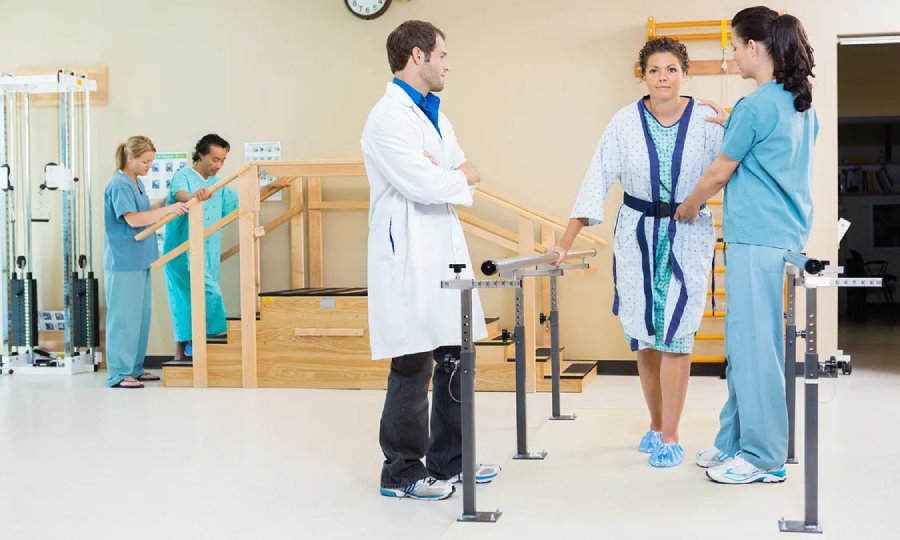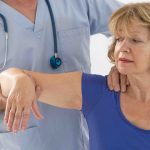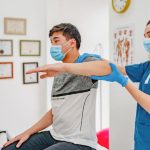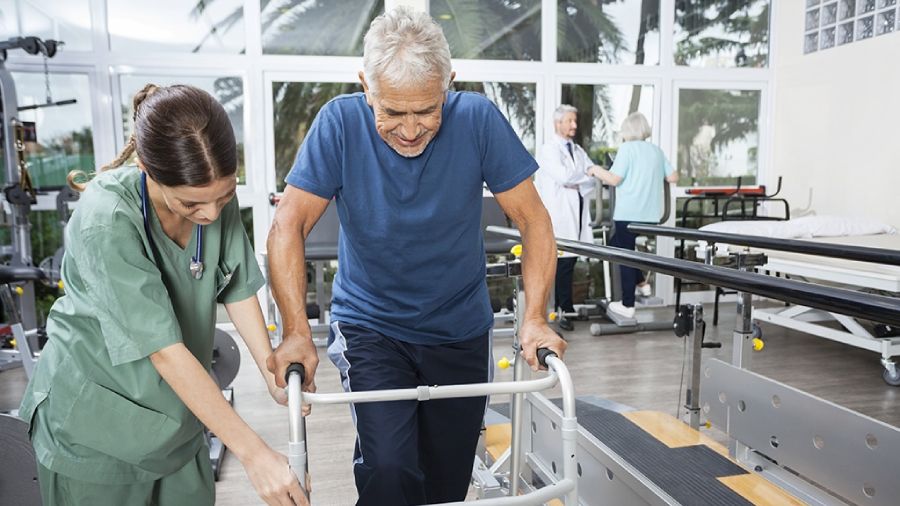
One of the many reasons I chose to work in Physical Medicine & Rehabilitation came from an inspirational patient encounter I had many years ago.
A 60-year-old man who had sustained a large stroke and transferred to our rehabilitation facility to get stronger. Due to the size and location of his stroke, he was told he would never be able to walk again. He was naturally disheartened and felt like giving up. Nonetheless, after weeks of hard work in our Acute Rehabilitation Unit, he was able to regain significant strength and independence. I will never forget the joy on his face when he stood from his wheelchair with the support of his walker and took his first steps.
These types of cases always remind me that every stroke survivor presents a new challenge and opportunity to maximize functionality and improve one’s quality of life. In this article, we will cover what stroke recovery looks like and how to optimize post-stroke rehabilitation.
What are the Consequences of Stroke?
To review what a stroke is and steps to preventing stroke, click here.
Strokes can take a variety of forms and cause a wide array of deficits, from cognitive and language problems, to hemiplegia (weakness or paralysis on one side of the body) and balance difficulties, to altered vision and sensation.
The regions of the brain affected by a stroke predict the stroke patient’s resulting deficits and help guide the recovery process.
- Strokes that affect the front of the brain (anterior circulation) usually cause weakness and numbness on one side of the body, as well as possible cognitive deficits. Stroke patients can have profound speech deficits (aphasia) or difficulty with spatial awareness and sometimes ignore half their vision (hemispatial neglect).²
- Strokes that involve the back of the brain (posterior circulation) are less common. Symptoms include dizziness, vertigo, poor coordination, and sometimes difficulty with sight, speech, and swallowing.
There are also additional issues that can arise after a stroke in any location. The loss of bladder and bowel control (incontinence) can be a difficult problem after strokes due to altered pathways for controlling these bodily functions. Abnormal muscle stiffening, also called spasticity, can also develop after damage to brain tissue and lead to pain or limitations in range of motion. Moreover, pain itself is often a prominent feature after a stroke due to altered sensory feedback provided to the brain.
How To Maximize Stroke Recovery
Stroke rehabilitation needs to not only address the many commonalities discussed above, but also be tailored to the specific deficits based on the brain territories that have been damaged.
Initial Treatment
After a stroke, patients usually require initial stabilization in the hospital. This includes respiratory support, blood pressure control, intracranial pressure monitoring, and patient monitoring.
This may also involve administration of tissue plasminogen activator (tPA), a blood clot buster drug used in the treatment of ischemic strokes. Strict criteria is used to determine who is eligible for tPA to ensure it is safe, including time from stroke onset, any history of bleeding, and other factors involving the patient’s prior medical conditions. If the internal carotid artery (ICA) is involved, a Carotid Endarterectomy (CEA) may be done, which is a surgery that removes the plaque clogging up the artery.³

Rehabilitation
One of the most important aspects in recovery from stroke is the subsequent rehabilitation. After initial stabilization has occurred, rehabilitation should be started as soon as possible. The many different consequences of a stroke call for a broad approach, including rehabilitation efforts from physical, behavioral, cognitive, and social points of view.
Acute Rehabilitation Unit (ARU)
Depending on the severity of the stroke, patients may qualify for an Acute Rehabilitation Unit (ARU), which serves as a transition between the hospital and home. During their time in ARU, patients work with therapists for at least 3 hours a day, all while having their medical issues managed by a rehabilitation doctor. Starting therapies early and aggressively can help improve long-term outcomes. Stroke patients may stay from as little as a few days to several weeks in ARU based on their independence level and progress.
Physical Therapy (PT)
The goal of physical therapy is to regain strength and mobility. Physical therapists emphasize exercise programs that consist of positioning, range of motion, strengthening, mobilization, and endurance training. After a stroke, there is additional importance of re-learning specific movement patterns and allowing sensation to guide movement.
Occupational Therapy (OT)
The goal of occupational therapy is to regain independence with daily activities. Tasks include practicing self-feeding, showering, toothbrushing, shaving, and self-dressing. An occupational therapist may also help a stroke patient to cook and manage one’s bowel and bladder independently.
Speech and Language Therapy (SLP)
Speech therapy includes two main areas of focus. The first is practicing safe swallow techniques. Since 51–78% of stroke patients have difficulty swallowing (dysphagia), this is particularly important to prevent choking.⁴ If people are unable to swallow safely, alternative forms of nutrition (e.g. tube feeding) are considered.
The second goal of speech therapy is to work on language and cognition. For those with aphasia or cognitive deficits, a speech therapist often makes simple communication boards and works on other strategies to improve recall, memory, writing, and speech.
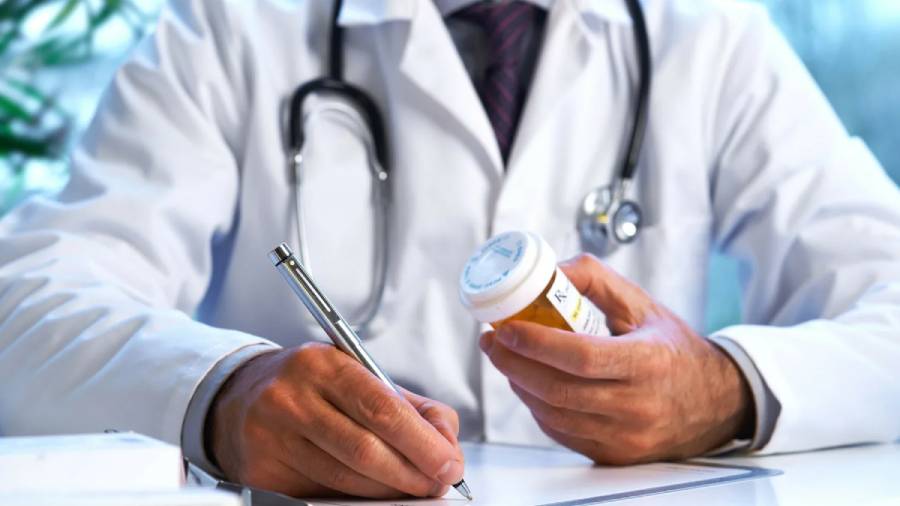
Taking Medications
Medications often pile up quickly after a stroke. The medical issues that may have led to the stroke, such as high blood pressure or blood clots, need to be treated aggressively. An antiplatelet agent (aspirin or clopidogrel) or an anticoagulant (warfarin) can also be used for prevention of another stroke.
Lastly, the individual consequences of stroke — conditions like spasticity, bladder incontinence, and bowel incontinence — also need to be addressed. With any of these medications, it is important to be supervised under the care of a healthcare provider to avoid improper management or unwanted side effects. Here some of the common medication for each of these deficits:
Spasticity
As mentioned above, spasticity often creates limitations in range of motion, decreased function of the limbs involved, and pain. Common medications include baclofen or dantrolene, which often require 3–4 administrations throughout the day.
Bladder Incontinence
About 50% of stroke patients experience the loss of bladder control in their first month.⁵ Incontinence can be a complicated issue, but medications like tamsulosin can be used to help initiate voiding, while medications like oxybutynin help can store urine in the case of overactive bladder.
Bowel Incontinence
The loss of bowel control occurs in about 34% of stroke patients, but it usually resolves within the first few months.⁵ If not, there are a few medication classes that may help promote complete, regular emptying, such as stool softeners (colace), stool stimulants (senna), and suppositories (dulcolax).
Mood disorders
Depression is reported to be present in about 33% of patients after a stroke.⁶ Although mood changes after a stroke are considered normal adjustment, this often lingers longer than is expected and interferes with quality of life. In these cases, antidepressants should be considered. Common options include citalopram (celexa), escitalopram (lexapro), fluoxetine (prozac), or sertraline (zoloft).
How to Manage Stroke Medications
Between treating the stroke itself, optimizing other variables like blood pressure and cholesterol, and managing these consequences of the stroke, patients can easily end up taking many daily medications, most of which they were not on previously. This can be overwhelming, particularly in those who are trying to focus on other aspects of their recovery, such as following their therapy schedules and getting back to their prior life.
With the emergence of new technologies, there are streamlined alternatives to manually managing complex medication routines. For instance, Hero has created an automated medication dispensing system that simplifies the process of medication management in the home by organizing and dispensing medications when they are due. Hero’s connected app provides patients with personalized medication adherence reports, so providers are able to make more accurate medication adjustments.
Video: “Rehabilitation after a stroke”
A set of exercises for rehabilitation of post-stroke patients. Set No1 is aimed at improving the functions associated with mobility in bed.
For additional information about the rehabilitation after a stroke you can watch a video demonstrating exercises and rehabilitation recommendations.
The Bottom Line for Stroke Recovery
Strokes can present themselves in many different ways, and recovery can vary drastically depending on their severity. Key aspects to maximize recovery include 1) proper stroke rehabilitation and 2) medication management.
- Rehabilitation is key in improving strength and addressing one’s deficits following a stroke. Rehabilitation does not end after the transition home — even when the formal therapies end, patients should continue their exercise regimen to maximize their functional improvements. Although most of the recovery after a stroke occurs in the first three months, improvements continue for about one year following a stroke.
- Medication management is also instrumental in both treating the consequences after a stroke, as well as preventing a repeat stroke. In fact, the risk of a second stroke is 13% within the first year and 30% within the lifetime, making medication adherence especially crucial to lower this likelihood.⁷ Luckily, technologies such as Hero have made this difficult problem more straightforward for patients by offering automated medication dispensing.
Although strokes are debilitating for patients and their families, undergoing extensive rehabilitation and addressing the factors that led to the stroke along with its consequences can maximize one’s quality of life and level of independence.
It is important to remember that since every case is different, it is impossible to predict exact outcomes. Some stroke survivors have surprisingly good results that go above and beyond our expectations, like the man I met who was able to walk again after his large stroke. Keeping these concepts of rehabilitation and medication management in mind during the recovery process goes a long way in setting yourself up for success.
Source and References
- Jawabri KH, Sharma S. Physiology, Cerebral Cortex Functions. [Updated 2021 Feb 14]. In: StatPearls [Internet]. Treasure Island (FL): StatPearls Publishing; 2021 Jan-.
- Konan LM, Reddy V, Mesfin FB. Neuroanatomy, Cerebral Blood Supply. [Updated 2020 Jul 31]. In: StatPearls [Internet]. Treasure Island (FL): StatPearls Publishing; 2021 Jan-.
- Findlay JM, Marchak BE, Pelz DM, Feasby TE. Carotid endarterectomy: a review. Can J Neurol Sci. 2004 Feb;31(1):22–36. PMID: 15038468.
- Martino R, Foley N, Bhogal S, Diamant N, Speechley M, Teasell R. Dysphagia after stroke: incidence, diagnosis, and pulmonary complications. Stroke. 2005 Dec;36(12):2756–63. Epub 2005 Nov 3. PMID: 16269630.
- Nakayama H, Jørgensen HS, Pedersen PM, Raaschou HO, Olsen TS. Prevalence and risk factors of incontinence after stroke. The Copenhagen Stroke Study. Stroke. 1997 Jan;28(1):58–62. PMID: 8996489.
- Hackett ML, Yapa C, Parag V, Anderson CS. Frequency of depression after stroke: a systematic review of observational studies. Stroke. 2005 Jun;36(6):1330–40. Epub 2005 May 5. PMID: 15879342.
- Burn J, Dennis M, Bamford J, Sandercock P, Wade D, Warlow C. Long-term risk of recurrent stroke after a first-ever stroke. The Oxfordshire Community Stroke Project. Stroke. 1994 Feb;25(2):333–7. Erratum in: Stroke 1994 Sep;25(9):1887. PMID: 8303740.

Check out the demo version of our workouts for rehabilitation of post-stroke patients on YouTube
You can find more information about Stroke in our Library of Articles.
Our website presents sets of exercises for the rehabilitation of post-stroke patients in the following four areas:
-
A SET OF EXERCISES FOR REHABILITATION OF POST-STROKE PATIENTS. SET №1 IS AIMED AT IMPROVING THE FUNCTIONS ASSOCIATED WITH MOBILITY IN BED
-
EXERCISES FOR REHABILITATION OF POST-STROKE PATIENTS. SET №2 IS AIMED AT IMPROVING THE MOBILITY AND STABILIZATION OF THE PELVIC COMPLEX
-
A SET OF EXERCISES FOR REHABILITATION OF POST-STROKE PATIENTS. SET №3 IS AIMED AT IMPROVING THE MOBILITY AND FUNCTION OF THE UPPER LIMB, STABILIZING THE SHOULDER GIRDLE
-
A SET OF EXERCISES FOR REHABILITATION OF POST-STROKE PATIENTS. SET №4 IS AIMED AT IMPROVING THE MOBILITY AND FUNCTION OF THE LOWER LIMB, STABILIZING THE PELVIC GIRDLE
You may also find useful information and sets of exercises in the section APHASIA AND DYSARTHRIA, where 5 sets of exercises for rehabilitation for speech disorders are currently presented.

